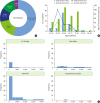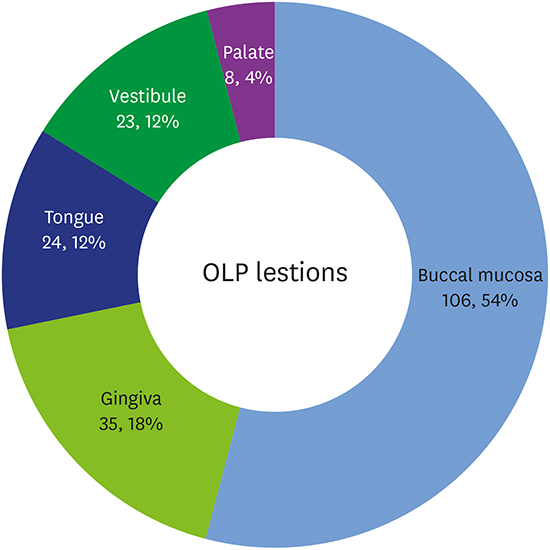1. Alrashdan MS, Cirillo N, McCullough M. Oral lichen planus: a literature review and update. Arch Dermatol Res. 2016; 308:539–551.

2. McCartan BE, Healy CM. The reported prevalence of oral lichen planus: a review and critique. J Oral Pathol Med. 2008; 37:447–453.

3. Kurago ZB. Etiology and pathogenesis of oral lichen planus: an overview. Oral Surg Oral Med Oral Pathol Oral Radiol. 2016; 122:72–80.

4. Dissemond J. Oral lichen planus: an overview. J Dermatolog Treat. 2004; 15:136–140.

5. Naylor GD. Treating erosive lichen planus with griseofulvin: a report of four cases. Quintessence Int. 1990; 21:943–947.
6. Carrozzo M, Gandolfo S. The management of oral lichen planus. Oral Dis. 1999; 5:196–205.

7. McCreary CE, McCartan BE. Clinical management of oral lichen planus. Br J Oral Maxillofac Surg. 1999; 37:338–343.

8. Scully C, Beyli M, Ferreiro MC, Ficarra G, Gill Y, Griffiths M, et al. Update on oral lichen planus: etiopathogenesis and management. Crit Rev Oral Biol Med. 1998; 9:86–122.

9. Hambly JL, Haywood A, Hattingh L, Nair RG. Comparison between self-formulation and compounded-formulation dexamethasone mouth rinse for oral lichen planus: a pilot, randomized, cross-over trial. J Investig Clin Dent. 2017; 8:e12225.

10. Pedersen A, Klausen B. Glucocorticosteroids and oral medicine. J Oral Pathol. 1984; 13:1–15.

11. Roopashree MR, Gondhalekar RV, Shashikanth MC, George J, Thippeswamy SH, Shukla A. Pathogenesis of oral lichen planus--a review. J Oral Pathol Med. 2010; 39:729–734.
12. Singh N, Scully C, Joyston-Bechal S. Oral complications of cancer therapies: prevention and management. Clin Oncol (R Coll Radiol). 1996; 8:15–24.

13. Lockhart PB, Sonis ST. Alterations in the oral mucosa caused by chemotherapeutic agents. A histologic study. J Dermatol Surg Oncol. 1981; 7:1019–1025.
14. Lamey PJ, Gibson J, Barclay SC, Miller S. Grinspan's syndrome: a drug-induced phenomenon? Oral Surg Oral Med Oral Pathol. 1990; 70:184–185.

15. Lavaee F, Majd M. Evaluation of the association between oral lichen planus and hypothyroidism: a retrospective comparative study. J Dent (Shiraz). 2016; 17:38–42.
16. Li D, Li J, Li C, Chen Q, Hua H. The association of thyroid disease and oral lichen planus: a literature review and meta-analysis. Front Endocrinol (Lausanne). 2017; 8:310.

17. Eisen D. The clinical features, malignant potential, and systemic associations of oral lichen planus: a study of 723 patients. J Am Acad Dermatol. 2002; 46:207–214.

18. Scully C, el-Kom M. Lichen planus: review and update on pathogenesis. J Oral Pathol. 1985; 14:431–458.

19. Mignogna MD, Lo Russo L, Fedele S. Gingival involvement of oral lichen planus in a series of 700 patients. J Clin Periodontol. 2005; 32:1029–1033.

20. Holmstrup P, Schiøtz AW, Westergaard J. Effect of dental plaque control on gingival lichen planus. Oral Surg Oral Med Oral Pathol. 1990; 69:585–590.

21. Guiglia R, Di Liberto C, Pizzo G, Picone L, Lo Muzio L, Gallo PD, et al. A combined treatment regimen for desquamative gingivitis in patients with oral lichen planus. J Oral Pathol Med. 2007; 36:110–116.

22. López-Jornet P, Camacho-Alonso F. Application of a motivation-behavioral skills protocol in gingival lichen planus: a short-term study. J Periodontol. 2010; 81:1449–1454.

23. Petersilka GJ, Arweiler NB, Otto J, Wittig T. Non-interventional study to collect data for the application of lidocaine gel 2% during scaling and root planing and professional mechanical plaque removal. Clin Oral Investig. Forthcoming. 2018.

24. Al-Hashimi I, Schifter M, Lockhart PB, Wray D, Brennan M, Migliorati CA, et al. Oral lichen planus and oral lichenoid lesions: diagnostic and therapeutic considerations. Oral Surg Oral Med Oral Pathol Oral Radiol Endod. 2007; 103 Suppl:S25.e1–S25.e12.

25. van der Meij EH, Schepman KP, van der Waal I. The possible premalignant character of oral lichen planus and oral lichenoid lesions: a prospective study. Oral Surg Oral Med Oral Pathol Oral Radiol Endod. 2003; 96:164–171.

26. Fitzpatrick SG, Hirsch SA, Gordon SC. The malignant transformation of oral lichen planus and oral lichenoid lesions: a systematic review. J Am Dent Assoc. 2014; 145:45–56.

27. Cheng YS, Gould A, Kurago Z, Fantasia J, Muller S. Diagnosis of oral lichen planus: a position paper of the American Academy of Oral and Maxillofacial Pathology. Oral Surg Oral Med Oral Pathol Oral Radiol. 2016; 122:332–354.

28. Gonzalez-Moles MA, Scully C, Gil-Montoya JA. Oral lichen planus: controversies surrounding malignant transformation. Oral Dis. 2008; 14:229–243.









 PDF
PDF ePub
ePub Citation
Citation Print
Print




 XML Download
XML Download